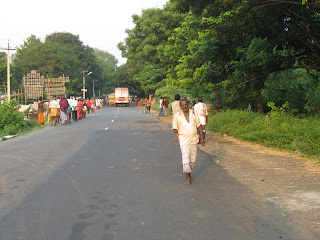I have a busy day planned ahead of me. First off darshan at 6 a.m. of my Guru, Sri Nannagaru at his ashram in Rajiv Gandhi Nagar (about 2 kms from Ramana Ashram). At 7.30 a.m. I am invited to a puja at the Animal Shelter, connected with the formation of their new Trust. (I will be posting a narrative further on this in the upcoming Arunachala Grace Newsletter due out at the end of the month. For your free subscription please check out at the left hand column of this Blog).
After the puja, I plan on going to Arunachaleswarar Temple to see what is happening there. In the afternoon Sri Nannagaru is meant to be giving darshan again at 4.00 p.m. and then at 6.00 p.m. I have arranged to meet friends from Kerala who are visiting Arunachala for Deepam. After meeting up, we then plan to go to Sri Sathya Sai bhajans at a devotee's house, to celebrate Swamis birthday.
Well had a very nice darshan and now on my way to the Animal Shelter.

As always over the Deepam Festival there is a 4-day Cattle Fair at Tiruvannamalai, at which cattle, horses and donkeys and a vast array of related accroutements are on sale.
 Below a vertiable oasis of fresh drinking water available for the upcoming inundation of a million pilgrims eager to perform giripradakshina of Arunachala.
Below a vertiable oasis of fresh drinking water available for the upcoming inundation of a million pilgrims eager to perform giripradakshina of Arunachala.
On the side of the road, some fellows sitting on a hillock of corn cobs.

Below, a rather interesting form of transportation, which seems to me to be a homemade job - but rather a smart vehicle nonetheless.

Nearly at the Animal Hospital, and my timing is perfect, as puja is ready to start. Hope to post some very nice photos of the puja in a couple of days. After the puja and some sweets and tea (yummy!)onward to the Cattle Fair.

Here are some of the young bulls which will be sold and used to pull carts loaded up with agricultural items, construction brick-a-brac, and a host of other kinds of loads.

The Cattle Fair is beginning to get busy, but its still very early in the morning. As well as cows and bulls, there will also be some nice ponies and horses on sale. The green in the back of the photograph is Arunachala.

All kinds of ropes and ornaments for the creatures are on sale at the Cattle Fair.

In the next photograph a very cheerful man making ornaments for the cows.

The pink building on the side of the below photograph, is the newly constructed pilgrim choultry, at which visiting pilgrims are able to stay during short trips to Arunachala.







































